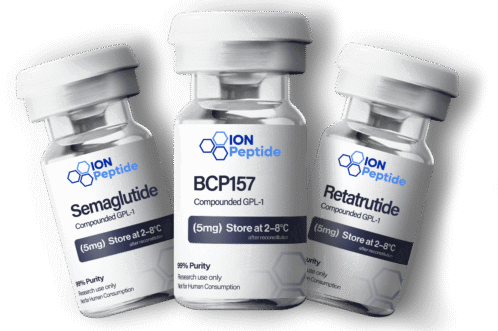Peptide Storage
By Peptide Information
At IonPeptide.com, we believe that knowledge is power — especially when it comes to science. Our peptides are offered exclusively for in-vitro research purposes, giving scientists reliable tools to explore breakthroughs in medicine, biology, and biotechnology.
Important Notice: Our peptides are not approved for human or animal use, nor are they intended to diagnose, treat, or cure any disease. They are strictly for laboratory research and educational applications.
Best Practices For Storing Peptides
Proper storage is essential for keeping peptides stable, potent, and ready for reliable research use. By following best practices, you can extend peptide shelf life, prevent degradation, and protect the integrity of your experiments.
General Storage Guidelines
Keep Cold and Protected from Light: Once received, peptides should be stored in a cool, dark environment.
Short-Term Storage (Days to Weeks): Refrigerate peptides at 4°C (39°F). Lyophilized peptides are typically stable at room temperature for 30–60 days but refrigerating them ensures maximum stability.
Long-Term Storage (Months to Years): Freeze peptides at –80°C (–112°F) whenever possible to maintain stability for years.
Avoid Freeze-Thaw Cycles: Repeated freezing and thawing can degrade peptides. Instead, aliquot solutions into small portions before freezing.
Avoid Frost-Free Freezers: These fluctuate in temperature during defrost cycles, which can harm peptide stability.
Preventing Oxidation and Moisture Contamination
Peptides are highly sensitive to air and moisture, which can cause them to degrade or lose potency. To protect your peptides:
Avoid Moisture: Always let peptides warm to room temperature before opening after freezer storage. This prevents condensation from forming on the container or peptide.
Limit Air Exposure: Open containers only as long as needed, then reseal them tightly. For maximum protection, store under a dry, inert gas (like nitrogen or argon) to reduce oxidation risk.
Watch Sensitive Sequences: Peptides containing cysteine (C), methionine (M), or tryptophan (W) are especially prone to oxidation and need extra care.
Aliquot for Convenience: Divide peptides into smaller vials before storage so you only open what you need — reducing repeated air exposure and freeze-thaw cycles.
These steps can significantly extend your peptide’s stability and preserve its activity for long-term use.
Storing Peptides In Solution
Peptides are most stable when lyophilized (freeze-dried). Once dissolved, their shelf life is shorter and they are more vulnerable to bacterial contamination — especially peptides containing Cys, Met, Trp, Asp, Gln, and N-terminal Glu.
If you must store peptides in solution:
Use sterile buffers at pH 5–6.
Aliquot to avoid repeated freeze-thaw cycles.
Store refrigerated at 4°C (39°F) for short-term use (up to 30 days).
Keep unstable peptides frozen when not in use to maintain integrity.
Peptide Storage Containers
Storage containers should be clean, clear, structurally sound, and chemically resistant. Both glass and plastic vials can be used, but:
Polystyrene vials are clear but not highly resistant to solvents.
Polypropylene vials are more chemically resistant and translucent.
Glass vials are ideal for long-term storage but may need protective sleeves to avoid breakage.
If peptides are initially shipped in plastic vials, you can transfer them to glass containers for optimal long-term stability.
Peptide Storage Guidelines: General Tips
When storing peptides, keep these best practices in mind:
Store Cold and Dry: Keep peptides in a cool, dark place away from moisture.
Minimize Freeze-Thaw Cycles: Aliquot into smaller portions to avoid repeatedly thawing and refreezing.
Limit Air Exposure: Open containers only when necessary and reseal quickly.
Protect from Light: Light can degrade peptides over time, so keep them shielded.
Avoid Long-Term Storage in Solution: Whenever possible, store peptides lyophilized (freeze-dried).
Aliquot by Experimental Needs: Divide into amounts you’ll use per experiment for convenience and stability.
Following these simple steps helps maintain peptide integrity and ensures reliable, reproducible results in your research.


